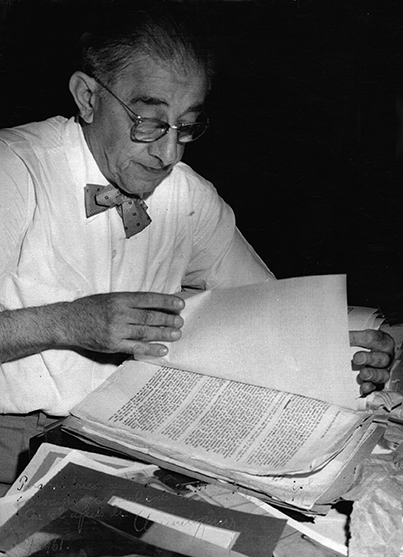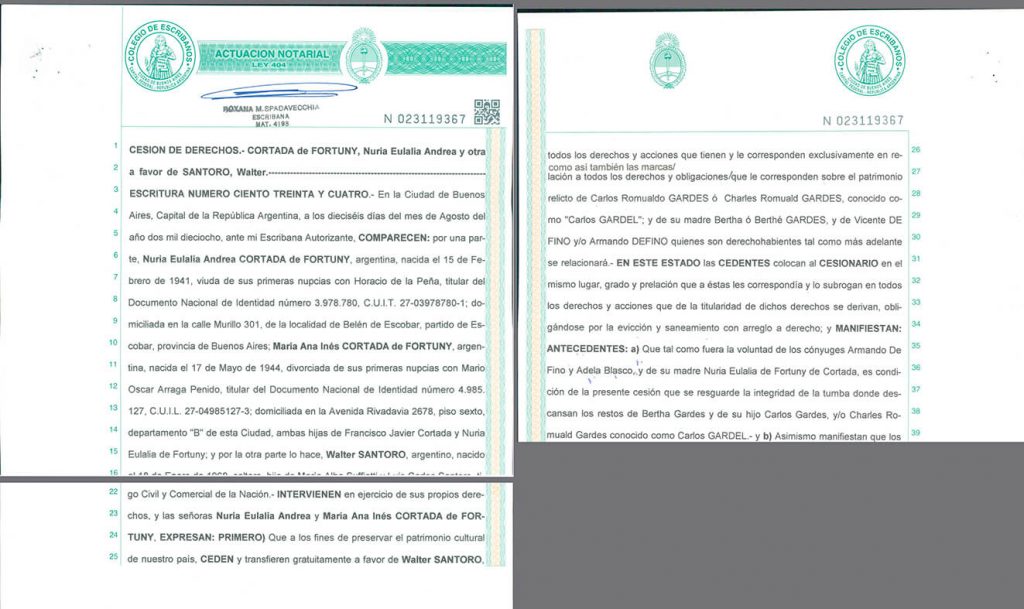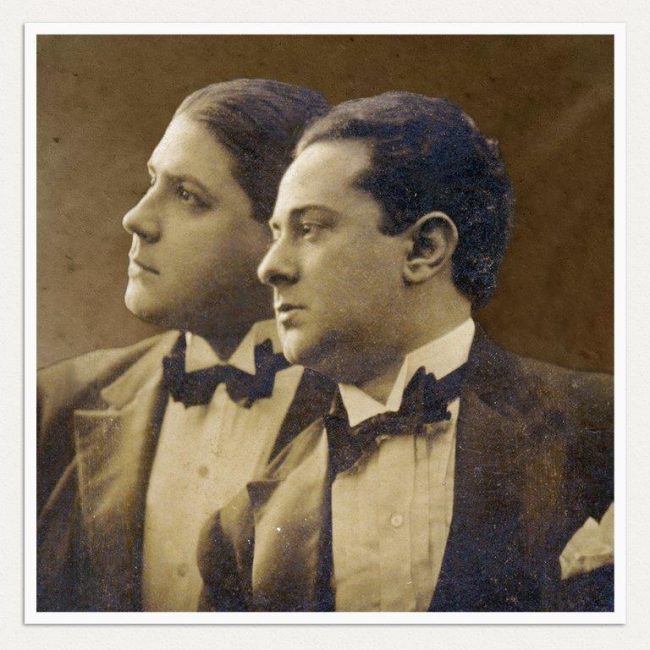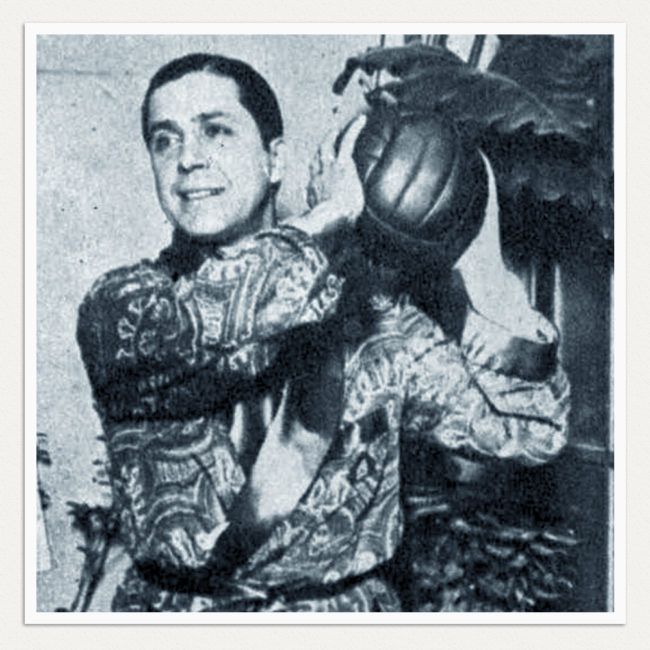SUCESO GARDELIANO N°13 - 02/03/2020
Historia de la herencia de Carlos Gardel hasta nuestros días
Entrevista Nuria Eulalia Andrea Cortada de Fortuny, heredera de Carlos Gardel, Bertha Gardés y Armando Defino. La historia tras la muerte de Gardel; el patrimonio olvidado en una casa de Río Ceballos durante 70 años.
Presentación
Esta historia pretende poner claridad a lo ocurrido con la sucesión y los derechos de la obra de Carlos Gardel, y la sucesión que da origen a la creación por parte de los sucesores de una Fundación Internacional Carlos Gardel, que ordene y mantenga viva su memoria.
Desde la fundación, creemos que haberla creado es un acto de justicia y un derecho de los argentinos a proteger nuestra historia. Tener que explicar quién fue Carlos Gardel parece ser innecesario, pero vale la pena recordar que las costumbres y tradiciones que se transmiten de generación en generación, son igual de importante que otros tipos de patrimonio y merece ser cuidado del mismo modo, forman parte del patrimonio inmaterial de los pueblos.
Carlos Gardel es parte activa de nuestra vida en forma consciente e inconsciente, desconocer la historia de este excepcional artista, y su contribución a la historia de nuestro país, y la relación de Buenos Aires, el tango y Gardel, en cualquier parte del mundo, es negar quienes somos y de dónde venimos, reguardar su memoria nos recuerda a dónde vamos.
Existe un antes y después de Gardel. La Fundación tiene como objetivo dentro de su misión despertar en las actuales y futuras generaciones, el sentido de identidad nacional como conquista de derechos, de pertenencia a una sociedad y resguardar el futuro, como parte de nuestra identidad.
La entrevista
A modo de prólogo
Muy pocas veces, o casi nunca, desde la muerte de Gardel y luego su madre, la gente se ha preguntado, que fue de su herencia, la mayoría recordaba como último sucesor a Armando De fino, su amigo y albacea, y el heredero de su herencia, es por esos que creemos que es importante que la gente conozca esta historia contada por una de las protagonistas, y como este patrimonio permaneció oculto durante 70 años.
Walter Santoro.
¿Cómo nació el vínculo con Armando Defino?
Nuria: Para esto tenemos que remontarnos a la llegada de mi familia a Buenos Aries. Mi abuelo materno, Ramón de Fortuny, llegó de Cataluña, España, con su familia, integrada por su esposa Armonía y sus tres hijas: mi madre -Nuria- y sus hermanas Elena y Gladys, la menor, a la que llamábamos Ninota, que nació en Montevideo en 1922 y hoy vive en España; es la única sobreviviente de esa generación y tiene una excelente memoria. Yo la suelo llamar para consultarle fechas y datos que no recuerdo.
Mi abuelo Ramón, por mandato de la Compañía Belga de Electricidad, fue transferido en el año 1925, de la planta de Montevideo construida 3 años antes, a montar el equipamiento de la usina eléctrica de Buenos Aires. La Usina se había empezado a construir varios años antes, pero faltaba instalar los equipos para la generación y distribución de la energía.
Mi abuelo era oriundo de Barcelona, de una familia noble. Su madre en España tenía entre su personal doméstico a Adela Blasco, una chica joven de origen humilde que quería emigrar en busca de un mejor porvenir. Adela logró viajar a Buenos Aires y consiguió trabajo en la Compañía Inglesa de Telefonía.
Tras haber perdido todo contacto con su familia y conocidos en España; al igual que todos los inmigrantes en Buenos Aires, solían reunirse con sus comunidades. De esta forma mi abuelo se reencontró con Adela, que ya estaba en pareja con Armando Defino, en el café Soviet de la Avenida de Mayo, punto de reunión de la colectividad catalana en Buenos Aires, donde solían concurrir a diario cerca de las 20 horas.
Desde entonces entablaron una profunda amistad; Adela con mi tía Armonía y mi abuela, y Armando con mi abuelo Ramón. Los cuatro compartían comidas, noches de canastas y salidas diariamente.
En 1940 mi familia compró una quinta en la localidad de Castelar -cerca de la actual Avenida Gaona- en donde nos solíamos reunir. Un año más tarde Armando compró una quinta a pocas cuadras; luego mi abuelo vendió la suya y todos comenzamos a frecuentar la quinta de Armando casi todos los fines de semana. Allí compartí con ellos toda mi infancia, a partir de mis cuatro años de edad.
Varios años antes del accidente trágico, Carlos Gardel le había pedido a Armando que se ocupara de su madre -Doña Bertha- si le sucediera algo, seguramente debe haber intuido entre tanto viaje, que algo podría ocurrirle. Tras producirse la muerte de Gardel en 1935, Armando tras los deseos de Carlos le propone a Berta que se fuera a vivir con ellos, aunque la casa de Jean Jaurés era enorme y fría, carente de confort, no obstante Doña Berta quiso seguir habitando en ella después de la muerte Carlitos. Allí se encontraba con la sombra de su hijo querido, allí estaban todos sus recuerdos vivos, palpitantes, sobreponiéndose a la tristeza de la casona. Doña Berta no quiso aceptar la invitación del matrimonio De Fino, que le ofreció una habitación en la casa de la calle Saavedra 222. Una cuestión sentimental, además del recuerdo, la retenía en Jean Jaurés 735, un matrimonio de ancianos que vivía con ella y a quienes conoció al llegar al país con su pequeño Carlitos; Eran Don Fortunato y su esposa Doña Anaiz, quienes fueron unos padres para Gardel, y Gardel los apreciaba como tales.
Al morir Doña Anaiz en el año 39, cuatro años más tarde de la muerte de Gardel, Don Fortunato se fue a vivir con su hijo. Y ante la insistencia de Bertha en quedarse en la vieja casa, el matrimonio De Fino junto a la madre de Armando, Doña Pepa, dejó su casa de la calle Saavedra 222 y se mudaron con Berta, para poder cuidarla como le había prometido a Carlos, cumpliendo con el pedido de su amigo, y fue Adela quien se encargó de cuidar a las dos mujeres.
Cuando Doña Bertha se enfermó (de cáncer de útero, esto provocó que pasara sus últimos años postrada en una cama), mi padre, que era médico, la comenzó a atender a pedido de Armando; esto hizo que frecuentáramos asiduamente la casa de Jean Jaurés. Yo era muy chiquita, entre dos y tres años de edad, y recuerdo vagamente a una señora postrada en cama, que era Doña Bertha. También recuerdo a Doña Pepa, siempre sentada en una silla mecedora, al perro de Armando, un ovejero alemán llamado Indio, y a Adela cocinando; ella hacia que me enseñaba a cocinar y es uno de los mejores recuerdos de aquella época.
En julio de 1943 falleció Doña Bertha y pocos meses después murió Doña Pepa; decidimos seguir viviendo en la misma casa hasta el año 1946, donde se desocupó nuestra casa de la calle Saavedra 222 que habíamos alquilado precisamente cuando fuimos a vivir en ella. Nos mudamos a Saavedra, la casa era mucho más chica, así que la mayoría de los muebles y los objetos personales de Gardel y Bertha fueron llevados a la casa que mi abuelo había comprado en Río Ceballos; y alquilamos, a su vez la de Jean Jaurés en $ 330 pesos mensuales y en el año 1949 fue vendida al mismo inquilino.

La compra de la casa de Río Ceballos
En un viaje a Río Ceballos, mi abuelo había conocido al Doctor Ordoñez, que tenía una casa muy linda, que parecía un castillo. Como Ordoñez estaba muy enfermo, virtualmente moribundo, le ofreció a mi abuelo venderle la casa, con la condición de que cuide a Clarita, su hija adoptada. Mi abuelo aceptó la compra con las condiciones pactadas y ésa pasó a ser la casa de veraneo de toda la familia.
Tras la venta de Jean Jaurés que hizo Armando, quedaron muchos muebles y una gran cantidad de objetos que habían pertenecido a Gardel y a Bertha; todo eso se llevó a la casa de Río Ceballos, Córdoba. La casa era muy grande, tenía dos pisos y todos los muebles que no utilizábamos se guardaron en una de las habitaciones.

Carlos Gardel y Armando Defino se conocen
El hermano de Armando era agente teatral, y él presentó a Gardel con Defino. En ese tiempo Gardel atravesaba dificultades financieras y necesitaba a alguien que pusiera en orden sus cuentas. Armando fue esa persona y se hizo cargo a partir de ese momento como administrador y organizador de sus bienes y más tarde se convirtió en el albacea de Carlos Gardel.
A partir del accidente fatal en Medellín, Armando fue apoderado por Bertha para realizar los trámites de repatriación y también se ocupó de todos los bienes de Carlos Gardel en el exterior.
Cuando mi padre conoció a mi madre, y la herencia
Mi padre había sido médico en Cataluña y allí trabajó en un laboratorio muy famoso llamado De Belarden, donde se descubrió la vacuna contra la tuberculosis. Emigró a la Argentina como exiliado político y en el Casal de Cataluña de Buenos Aires conoció a un compatriota catalán que lo ayudó enviándole pacientes hasta tanto revalidara su título para ejercer la medicina en Argentina en forma legal. Ese compatriota español –que más adelante sería mi abuelo- pensaba que su hija estaba tuberculosa debido a su extrema delgadez, y acudió a mi padre por estudios. El diagnóstico dio negativo. Mi futura madre sólo padecía de un cuadro de desnutrición y debía aumentar de peso. Un cambio de hábitos alimenticios y de clima era lo indicado.
Una granja en Río Ceballos, Córdoba, fue la solución y al cabo de tres meses regresó a Buenos Aires completamente repuesta, mucho más gordita y con otro semblante. Como cortesía por no haberle cobrado los estudios y las consultas, mi abuelo invitó al médico catalán a una fiesta en el casino de la usina donde trabajaba. Allí el médico encontró a mi madre y al verla quedó prendado de ella, que en verdad estaba bastante enojada por el estudio de tuberculosis que le había ordenado realizar. De todos modos, allí se enamoraron y se casaron el 6 de enero de 1940. Un año más tarde nací yo, luego mi hermano y después mi hermana.
A Defino le encantaban los niños, pero no había podido tener hijos. Se encariñó con nosotros, siendo yo la preferida. Desde entonces, Armando y Adela me llevaban a todos lados, a los teatros, al cine e incluso a los teatros de revista a escondidas de mi mamá. Cuando nos quedábamos en la casa de Armando por las noches, siempre teníamos cine de Gardel; Armando preparaba un proyector de 16 mm, y nos pasaba las películas de Gardel.
Armando tuvo una vida familiar, apartada del mundo del tango. He conocido en su casa a Edmundo Guibourg y su esposa, unidos a Armando por la amistad con Gardel, y no recuerdo a nadie más. Nuestras dos familias estaban muy unidas; iban por las noches a la casa quinta a jugar a las cartas todos juntos. Adela dice en su testamento que mi madre pasó a ser la hija adoptiva o “del corazón” de Armando y Adela, y ese mismo cariño fue el que me transfirieron a mí.

En 1953 Armando se enfermó. Tuvo un infarto al que sobrevivió, pero ya no pudo seguir trabajando. Al no contar con ahorros y ningún otro recurso económico más que el trabajo, vendió la casa quinta Yaraví y mis padres les ofrecieron que se mudaran con nosotros. Mi padre alquilaba un piso en San Juan 3658, casi Boedo, y le cedió a Armando la parte de adelante del piso en tanto que nosotros nos quedamos con la parte posterior; desde ese momento convivimos todos juntos. Mi madre era dentista y tenía su consultorio en la misma casa. Ella y Adela pensaron que sería mejor irse a vivir todos juntos a una casa, y compraron un Petit Hotel en Recoleta que había pertenecido a Silvina Bullrich, en la calle Galileo 2459. Como pequeño detalle, a mí me había tocado la habitación de Silvina y mi mamá montó su consultorio en la planta baja, Armando se quedó con un gran living comedor, un cuarto, un baño y una cocina, y nosotros nos acomodamos en el primer piso.
Armando falleció en junio de 1962, cuando yo tenía 21 años. Adela quedó sola y allí comenzó la polución, el desfile de gente que venía a pedirle pertenencias de Gardel. A nosotros nos daba rabia toda esa gente; le venían a quitar, o robar los recuerdos. Adela tenía un armario lleno de discos de prueba de Gardel. Esa gente le lloraba y ella les regalaba discos hasta que no quedó ninguno. Le tomamos bronca al mundo del tango por culpa de esas personas, unos atorrantes que venían a despojar a una pobre mujer. Armando nunca quiso lucrar con Gardel; era un hombre muy honesto, con mucha integridad, y lo que percibió de derechos por Gardel tan solo le alcanzaba para vivir.
Pocos años después de la muerte de Armando, yo me había recibido, me casé y mi padre estaba muy enfermo. La casa era muy grande para ellos y mi mamá decidió mudarse. Vendieron la propiedad de la calle Galileo pero fueron estafados. Les iban a dar un dinero y dos departamentos chicos; la plata la recibimos pero el grupo comprador se declaró en quiebra y nunca recibimos los departamentos. Con el dinero que nos dieron, mis padres compraron una casa en la calle Laprida al 1700. En la planta baja vivía Adela y mi mamá tenía allí su consultorio; en la planta alta había un living, un dormitorio y una cocina.
Ya nos habíamos casado todos; solo quedaba soltero mi hermano menor. Al poco tiempo mi padre sufrió un infarto y murió en una cirugía en el Hospital Italiano. Con muchas dificultades económicas tuvimos que pedir dinero para poder enterrarlo. Fue un momento terrible, aún a pesar de que él era médico; lo había operado el doctor Liotta. Pasaron los años; murió mi abuelo Ramón y mi abuela se mudó a un departamento frente a la casa de mi madre y pasaban los días las tres mujeres juntas. En un viaje al campo en que Adela visitaba a mi hermana, falleció mientras dormía. Al mismo tiempo que la estaban enterrando, una familia “amiga” a la que ellos habían ayudado cuando vinieron de España, entraron al departamento y le robaron todo lo que quedaba.
En el año 2000 mi madre era una señora de edad avanzada y nos propuso, a mi hermana y a mí; que dejáramos todo arreglado en vida, para no tener que hacer una sucesión. Desde aquel momento hasta la muerte de mi madre en el año 2008, mi hermana y yo no quisimos tocar nada; recién entonces, ya fallecida fuimos a ver la casa de Río Ceballos, para poder venderla. No lo hicimos antes por respeto a mis padres que nos dieron todo. Nunca quisimos tomar algo en vida de mi madre. Como la casa era tan grande, un sector se usaba para vacacionar y otro era depósito. Allí nos encontramos con todas las pertenencias de Bertha y de Gardel. A medida que íbamos extrayendo esos objetos nos íbamos dando cuenta de la importancia de todo aquello. Sólo supimos que había que preservarlo para el futuro; era lo que más nos importaba. Siempre tuvimos conciencia clara en la familia de que éramos los herederos de Gardel, por consiguiente de Bertha y de Armando Defino. Había que entender que, cuando armando vendió la casa yo tenía 4 años y mi hermana 5, muy poco para darnos cuenta lo que había sucedido, y por eso que todo quedo en un limbo de la historia, de la herencia de Gardel, así como de Bertha, todo esto debido a que estábamos muy distanciados del mundo del tango a causa de los acopiadores de recuerdos. También Le habíamos cobrado desconfianza a los coleccionistas y por añadidura a toda la gente de tango, por lo que habían hecho con Adela. Por otro lado, nosotras estábamos avocadas a nuestras vidas; mi hermana como farmacéutica y yo con mi profesión de bioquímica; mis hijos se radicaron en los EEUU y tienen su vida, al igual que nuestros nietos y es por eso que decidimos ceder a favor de Walter Santoro la titularidad y herencia de todo aquello que recibimos de Gardel, de Bertha y de Armando. Creemos que él va a poder llevar adelante los deseos de Armando, como alguna vez nos dijo: “No quiero lucrar con Gardel sino mantener vivas su memoria y su obra.” y eso coincide plenamente con nuestros deseos. Adela lo dejó expresado en su testamento y nos pidió en vida que nos encarguemos de la bóveda porque allí descansaban también los restos de Armando, que ya no están más. En ese momento descubrimos que estaba muy abandonada.
Alfredo Echaniz, mi esposo, es quien descubrió de alguna manera, la importancia de toda aquella documentación y se dedicó a ordenarla y a comenzar a investigar sobre la historia de Gardel, y combinándolo con su profesión de diseñador gráfico, ordenó toda la documentación, y preparó una muestra que realizamos en el hotel de un amigo, donde por primera y única vez, se expuso gran parte de la colección. Alfredo también realizó un libro, llamado “Archivo Gardel”, donde se da a conocer gran parte de la historia de Armando Defino y de la vida con Gardel. Creemos que ésta es gran parte de la documentación que faltaba para cerrar un capítulo de nuestra historia.
Conocimos al señor Walter Santoro a razón de un conflicto que se estaba orquestando por la falta de mantenimiento y abandono de la Bóveda de Carlos Gardel en el cementerio de chacharita, él nos solicitó poder intervenir en el conflicto a favor de defender a Carlos Gardel y para ello, nos solicitó un poder que nos represente, para poder actuar en forma oficial. Con mi hermana vimos el trabajo que él venía realizado en defensa de nuestra historia y nuestro patrimonio, y decidimos realizar una cesión de todos los derechos a su favor, en forma gratuita, con el cargo y su compromiso de resguardar la obra y su imagen para el futuro de todos los argentinos y el mundo.
Entrevista realizada por Walter Santoro. Junio del 2019

Extracto de la cesión de derechos.
La Herencia, sus sucesiones
Hasta la fecha, la historia de Carlos Gardel, así como su legado artístico fue pasando a través de varias generaciones, sustentado en un fuerte sentido de identidad porteña y con una proyección internacional alcanzada por muy pocos de sus contemporáneos, en el mundo; pero existe una sucesión, hereditaria que pasamos a explicar.
Para entender esta historia, hay que remontarnos a la época en la que Carlos Gardel conoce a Armando Defino, (año 1931) quien en muy poco tiempo paso a ser su albacea y amigo. algunos años mas tardes, Gardel le plantea a Defino, la necesidad de dejar un testamento, en esa misma conversación, le solicita que si le ocurriera algo, que cuide a su madre -Doña Bertha Gardes-. Tras el accidente trágico, el 24 de junio 1935, Armando junto a Adela y su madre Doña Pepa, se mudaron a la casa de doña Bertha, en la calle Jean Jaurés 735, cumpliendo con el pedido de Carlos, y fue Adela quien se encargó de cuidar a las dos mujeres, hasta su muerte ochos años más tarde.
Las sucesiones
Carlos Gardel, deja bajo testamento del 7 de noviembre de 1933, a su madre Berthe Gardes, como heredera universal de todos sus bienes y derechos. Mediante testamento de fecha 2 de julio de 1942, Berthe Gardes nombra único y universal heredero de los bienes heredados de Carlos Gardel a Armando Vicente De Fino. Mediante testamento de fecha 7 de febrero de 1960, Armando De Fino, nombra como única y universal heredera a su esposa Adela Blasco de De Fino de todos sus bienes y derechos, aclarando que en caso de que ésta falleciera primero o en caso de muerte simultánea, luego de legar ciertas propiedades a su sobrino, y en el remanente de bienes nombra como única y universal heredera a Nuria Eulalia de Fortuny de Cortada (a quien como “nuestra hija en el afecto”), pidiendo a la misma que “…siga atendiendo como lo hemos hecho siempre mi esposa y yo, el monumento y la bóveda en Chacarita, donde reposan los restos de mi querido e inolvidable Carlos Gardel y los de su señora madre Berthe Gardes”.
Con fecha 27 de octubre de 2000, mediante cesión de derechos, la señora Nuria Eulalia de Fortuny de Cortada, dona gratuitamente a sus hijas Nuria Eulalia Andrea Cortada de Fortuny y María Ana Inés Cortada de Fortuny todos los derechos de propiedad y las acciones inherentes a esos derechos respecto de todas las cosas y bienes y objetos materiales o inmateriales que pertenecieron en vida a Carlos Gardel, a su madre Doña Berthe Gardes y a los sucesores de ésta Armando Vicente De Fino y doña Adela Blasco de quien la cedente es la única y universal heredera.
Mediante cesión de derechos de fecha 16 de agosto de 2018, las señoras Nuria Eulalia Andrea Cortada de Fortuny y María Ana Inés Cortada de Fortuny, ceden, en forma gratuita al Sr. Walter Santoro, todos los derechos de propiedad y las acciones inherentes a esos derechos respecto de todas las cosas y bienes y objetos materiales o inmateriales que pertenecieron en vida a Carlos Gardel, a su madre Doña Berthe Gardes, con el compromiso que custodiar su memoria e historia.
En cumplimiento de ese compromiso, el sr. Walter Santoro, decide crear para tal fin la Fundación Internacional Carlos Gardel, dando comienzo de esta manera a una nueva historia, entendiendo que Carlos Gardel es parte viva de la historia cultural de Buenos aires y por ello de todos los argentinos.

Foto recreación de los sucesores Gardel.
Walter Santoro para Fundación Internacional Carlos Gardel


